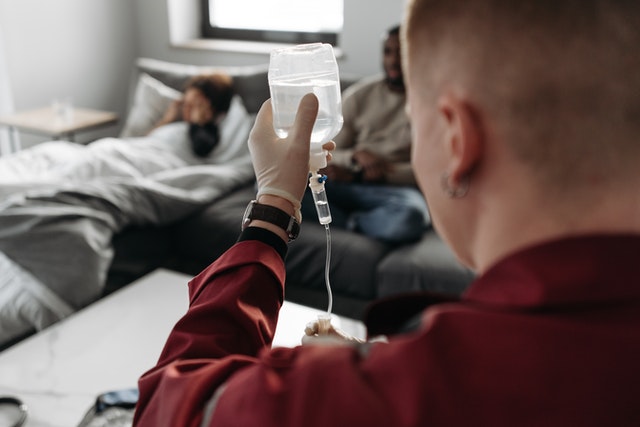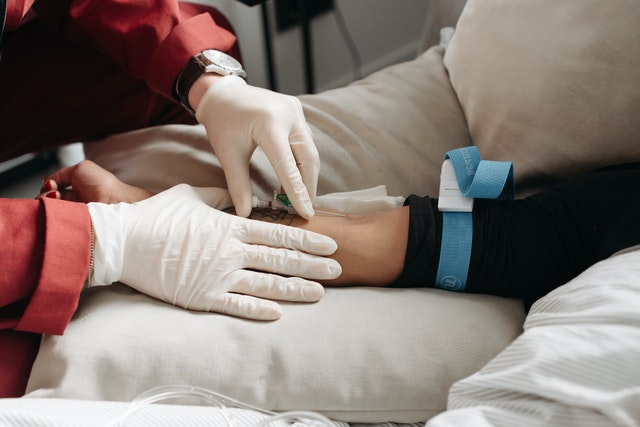Many EMT acronyms are used in emergency medical services to make procedures easier to remember for medical professionals. In this blog, we’ll show you the most frequently used acronyms.
Let’s get started with our free EMT practice test to pass your exam with a high score on your first attempt.
Basic EMT acronyms

ABCDE
Airway/ Breathing/ Circulation/ Disability/ Exposure
After determining that the scene is safe, the first step in the physical evaluation will be to verify your ABCDEs. This is an acronym that lists everything you should verify and maintain first.
BSI
Body – Substance – Isolation
This is used as a precaution for EMS professionals to shield and isolate themselves from bodily fluids such as blood, urine, and feces when administering medical care. BSI should be worn before every call, and depending on the nature of the call, may involve gloves, eye protection, a facemask, and a gown.
SAMPLE EMS acronym (History)
Symptoms/ Allergies/ Medications/ Past medical history/ Last oral intake/ Events
SAMPLE history is an abbreviation that helps you remember what questions to ask during your patient assessment. This sample medical acronym is the best standard for a patient’s subjective history, and it’s included in the state exam’s medical and trauma checklist. It’s designed to walk you through a thorough interview with the patient so you can learn more about what caused the patient’s illness.
OPQRST
Onset: When did the pain begin? Was it gradual or abrupt?
Provocation: Is there anything that makes the pain seem better or worse?
Quality: Can you explain the pain?
Radiate: Where is your anguish, Radiate? Is it able to travel to other parts of your body?
Severity: On a scale of one to ten, how severe is your pain?
Time: How long have you been suffering from the pain?
During an acute illness, this acronym is frequently used in conjunction with the SAMPLE acronym medical as a guide for asking questions about a patient’s symptoms, particularly pain. It’s an excellent acronym for learning about a person’s subjective history of the chest or abdominal pain. Each inquiry should be asked in order to gain a better knowledge of the symptoms of the patient.
AEIOU TIPS
AEIOU: Alcohol- Epilepsy – Infection – Opiates – Uremia
TIPS: Trauma – Insulin – Poisoning – Strokes
This is an abbreviation for the various reasons why someone could be unconscious or have a different state of consciousness. It’s critical to remember this list so you can start ruling them out as you conduct your assessment until you locate the source of the problem and can cure it.
AVPU
Alert – Voice – Pain – Unresponsive
This acronym is a method for recording and documenting a patient’s response in order to determine their state of consciousness.
SLUDGE
Salivation/ Lacrimation (tears)/ Urination/ Defecation/ Gastrointestinal disease/ Emesis
This is an abbreviation for the symptoms of a parasympathetic nervous system discharge, which can occur as a result of a chemical overdose or the intake of certain poisons.
DCAP
Deformities – Contusions – Abrasions – Punctures/penetrations
This is an abbreviation used during a trauma patient’s fast head-to-toe evaluation. Starting with the head, you’ll inspect each portion of the body for any of these symptoms, pausing only to address them if they’re life-threatening.
BTLS
Burns – Tenderness – Lacerations – Swelling
SOAP
Subjective – Objective – Assessment – Plan
The report’s format for your prehospital care is explained by this acronym.
Read more: What Jobs Can You Get With EMT Basic?
What is the acronym we use for medical patient assessment?

- A&O x 3: Alert and oriented to place, time, and person.
- A&O x 4: Alert and oriented to person, place, time, and event
- ABC: Airway – breathing – circulation
- NAD: No apparent distress
- BS: Breath sounds
- C/O: Complaint of
- DT: Delirium tremens
- FB: Foreign body
- CEPH: Cephalic
- CP: Chest pain
- Fx: Fracture
- NSR: Normal – Sinus – Rhythm
- PAC: Premature – Atrial – Contraction
- MS: Mental Status
- N/V: Nausea/vomiting
- PRB: Partial rebreather
- NKDA: No Known Drug Allergies
- PVC: Premature ventricular contraction
- RXN: Reaction
- AMS: Altered mental status
- BG: Blood glucose
- NRB: Non-rebreather
- BP: Blood pressure
- GI: Gastrointestinal
- GSW: Gunshot wound
- H/A: Headache
- HEENT: Head, eyes, ears, nose, throat
- HR: Heart rate or hour
- Hx: History
- JVD: Jugular vein distension
- LOC: Level of consciousness/ loss of consciousness
- N/V/D: Nausea/vomiting/diarrhea
- MS: Mental status change
- SOB: Shortness of breath
- MVC: Motor vehicle crash
- SQ: Subcutaneous
- T: Temperature
What is the abbreviation for a patient’s diagnosis?
- AKA: Above the knee amputation
- CNS: Central nervous system
- CABG: Coronary artery bypass graft
- DKA: Diabetic ketoacidosis
- A-FIB: Atrial fibrillation
- SVT: Supraventricular tachycardia
- T-SPINE: Thoracic spine
- AAA: Abdominal aortic aneurysm
- BKA: Below the knee amputation
- C-SPINE: Cervical spine
- CA: Cancer
- Dx: Diagnosis
- GYN: Gynecology or gynecological
- CAD: Coronary artery disease
- HTN: Hypertension
- ICP: Intracranial pressure
- SZ: Seizure
- MI: Myocardial infarction (heart attack)
- PE: Pulmonary embolus
- CHF: Congestive heart failure
- C-SECTION: Cesarean section
- COPD: Chronic obstructive pulmonary disease
- ST: Sinus tachycardia
- TIA: Transient ischemic attack
- VT: Ventricular tachycardia
- WAP: Wandering atrial pacemaker
If you care about NREMT Skills Sheets, you can try to visit our blog.
What are common EMT measurement abbreviations?
- AMT: amount
- g: Gram
- gtts: Drops
- APPROX: Approximately
- kg: Kilogram
- mcg: Microgram
- ASSOC: Associated
- mg: Milligram
- min: Minimum/ minute
What is the basic medical terminology?

The use of medical terminology to discuss body parts and locations is common.
- ABD – Abdomen (abdominal)
- LMP – Last menstrual period
- M – Male
- AMA – Against medical advice
- VS – Vital signs
- DOA – Dead on arrival
- WNL – Within normal limits
- YO (YOA) – years of age
- BILAT – Bilateral
- CSF – Cerebrospinal fluid
- DNR – Do not resuscitate
- PT – Patient
- ETOH – Ethanol
- ASA – Aspirin
- UOA – Upon our arrival
- EXT – External or extension
- F – Female
- ICU – Intensive care unit
- IM – Intramuscular
- IV – Intravenous
- KVO – Keep vein open
- L-SPINE – Lumbar spine
- PRN – As needed
- L/S-SPINE – Lumbarsacral spine
- LAT – Lateral
- lb – Pound
- LLQ – Left lower quadrant
- MED – Medicine
- NS – Normal saline
- PMH – Past medical history
- PO – Orally
- RLQ – Right lower quadrant
- LUQ – Left upper quadrant
- RUQ – Right upper quadrant
- Rx – Medicine or prescription
- Sx – Symptom
- S/P – Status post
- TKO – To keep open (refers to IVs – same as KVO)
Read more: How To Become An EMT?
What are EMT common treatment abbreviations?
- ET – Endotracheal
- EEG – Electroencephalogram
- ETT – Endotracheal tube
- L&D – Labor and delivery
- ACLS – Advanced cardiac life support
- CPR – Cardiopulmonary resuscitation
- NEB – Nebulizer
- CT – Cat scan
- CVA – Cerebrovascular accident (stroke)
- ECG – Electrocardiogram
- MSO4 – Morphine
- BVM – Bag-valve-mask
- NC – Nasal cannula
- PALP – Palpation
- Tx – Treatment
- ALS – Advanced life support
- BLS – Basic life support
- CATH – Catheter
That’s the list of EMT acronyms. There are a lot of terms to remember, right? Don’t worry, you can be familiar with many of them after working as an EMT for a certain time. We hope that our article can help you learn all the acronyms faster and easier.

PCCN vs CCRN: Which Certification Should I Take?
In this discussion, we will examine the fundamental distinctions between PCCN vs CCRN certifications, allowing you to make an informed and right decision about which certification is best for your nursing career progression.
June 20, 2023

Is PCCN Worth It? A Comprehensive 2024 Study Guide
In this article, we will provide all the enrollment criteria, how to apply, whether is PCCN worth it for you to obtain, and how to get a high mark.
June 20, 2023

PCCN Requirements - How to Become a Progressive Care Certified Nurse?
To become a progressive care nurse, you must first obtain the PCCN certification. This post will help you understand PCCN certification, PCCN requirements, and efficient approaches to obtaining this certification.
June 20, 2023
